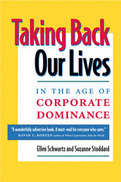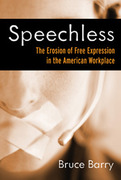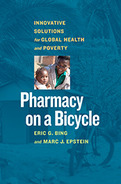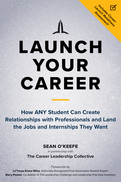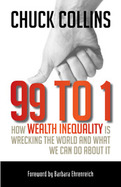- Reveals the profound impact of the global corporate economy on our daily lives
- Details 75 immediate and long-term Action Steps for empowering ourselves both individually and as a society
- Offers specific tips, ideas, and resources on how to pare down our lives and open up our time
- Provides questions for reflection that help readers to think in new ways about what matters most to them
2007
- Reveals the severe--and surprising--limits on free speech in the American workplace
- Includes vivid examples illustrating just how restricted workplace speech has become
- Suggests ways to expand employee rights while protecting employers' legitimate concerns
- Learn more at www.SpeechlessTheBook.com
This is a book about taking health care the last mile-sometimes literally-to prevent widespread, unnecessary, and easily avoided death and suffering.
Every four minutes, over 50 children under the age of five die. In the same four minutes, 2 mothers lose their lives in childbirth. Every year, malaria kills nearly 1.2 million people, despite the fact that it can be prevented with a mosquito net and treated for less than $1.50. Sadly, this list goes on and on. Millions are dying from diseases that we can easily and inexpensively prevent, diagnose, and treat. Why? Because even though we know exactly what people need, we just can’t get it to them. They are dying not because we can’t solve a medical problem but because we can’t solve a logistics problem. In this profoundly important book, Eric G. Bing and Marc J. Epstein lay out a solution: a new kind of bottom-up health care that is delivered at the source. We need microclinics, micropharmacies, and microentrepreneurs located in the remote, hard-to-reach communities they serve. By building a new model that “scales down” to train and incentivize all kinds of health-care providers in their own villages and towns, we can create an army of on-site professionals who can prevent tragedy at a fraction of the cost of top-down bureaucratic programs. Bing and Epstein have seen the model work, and they provide example after example of the extraordinary results it has achieved in Africa, Asia, and Latin America. This is a book about taking health care the last mile—sometimes literally—to prevent widespread, unnecessary, and easily avoided death and suffering. Pharmacy on a Bicycle shows how the same forces of innovation and entrepreneurship that work in first-world business cultures can be unleashed to save the lives of millions.- Offers a creative, entrepreneurial approach to bringing lifesaving health care to those who need it most
- Features real-world examples of this approach in action around the world
- Coauthored by a prominent health-care expert and a leading business professor and copublished by the prestigious George W. Bush Institute
- Read the press release here; for media review copies contact [email protected]
Every three minutes, nearly 50 children under the age of five dies. In the same three minutes, 2 mothers lose their lives in childbirth. Every year, malaria kills 655,000 people, despite the fact that it can be prevented with a mosquito net and treated for $1.41.
Sadly, this list goes on and on. Millions are dying from diseases that we can easily and inexpensively prevent, diagnose, and treat. Why? Because even though we know exactly what people need, we just cant get it to them. They are dying not because we can't solve a medical problem but because we cant solve a logistics problem.
In this profoundly important book, Eric Bing and Marc Epstein lay out a solution: a new kind of bottom-up health care that is delivered at the source. We need microclinics, micropharmacies, and microentrepreneurs located in the remote, hard-to-reach communities they serve. By building a new model that "scales down" to train and incentivize all kinds of health-care providers in their own villages and towns, we can create an army of on-site professionals who can prevent tragedy at a fraction of the cost of top-down bureaucratic programs.
Bing and Epstein have seen the model work, and they provide example after example of the extraordinary results it has achieved in Africa, Asia, and Latin America. They describe the principles and practices involved in implementing it and explain how to apply it to overcome specific health challenges.
This is a book about taking health care the last milesometimes literallyto prevent widespread, unnecessary, and easily avoided death and suffering. Pharmacy on a Bicycle shows how the same forces of innovation and entrepreneurship that work in first-world business cultures can be unleashed to save the lives of millions.
2011
Recounting controversial First Amendment cases from the Red Scare era to Citizens United, William Bennett Turner shows how weve arrived at our contemporary understanding of free speech. His strange cast of heroes and villains, some drawn from cases he has litigated, includes Communists, Jehovahs Witnesses, Ku Klux Klansmen, the worlds leading pornographer, prison wardens, dogged reporters, federal judges, a computer whiz, and a countercultural comedian. This is a fascinating look at how the scope of our First Amendment freedoms has evolved and the colorful characters behind some of the most important legal decisions of modern times.
2021
Did you know only 20 percent of jobs and internships are posted online? This means 80 percent of positions are filled in what Sean O'Keefe and others calls the hidden job market. This book will teach you how to tap into that 80 percent!
O'Keefe, in partnership with the Career Leadership Collective, is now sharing his proven eight-step Career Launch Method that will help any student explore career options and land the internships and jobs they want by creating professional relationships from scratch. This book demystifies the concept of intentional, proactive relationship building by teaching all the practical microsteps needed to succeed. And O'Keefe teaches readers how to "play the student card," turning inexperience and eagerness to learn into a powerful advantage.
Launch Your Career features first-person stories of students from all backgrounds and programs of study who have used the Career Launch Method to earn jobs or internships at all types of companies, nonprofits, government agencies, social enterprises, and institutions across the country and around the world.
The book includes the Career Launch Readiness Assessment, which helps students evaluate their competency in five key areas. This book will become a go-to resource for students looking to find internships and jobs, as well as a needed tool for colleges looking to increase retention rates and student's return on investment.
2012
Brings together facts and figures showing what "the 99% and the 1%" divide means in the real world and the damage it causes.
Over the past thirty years, we’ve seen a radical redistribution of wealth upward to a tiny fraction of the population. Here, activist Chuck Collins explains how it happened and marshals wide-ranging data to show exactly what the 99/1 percent divide means in the real world and the damage it causes to individuals, businesses, and the earth. Most important, he answers the burning question, what can be done about it? He offers a common-sense guide to bringing about a society that works for everyone: the 100 percent. This is a struggle that can be won. After all, the odds are 99 to 1 in our favor.


